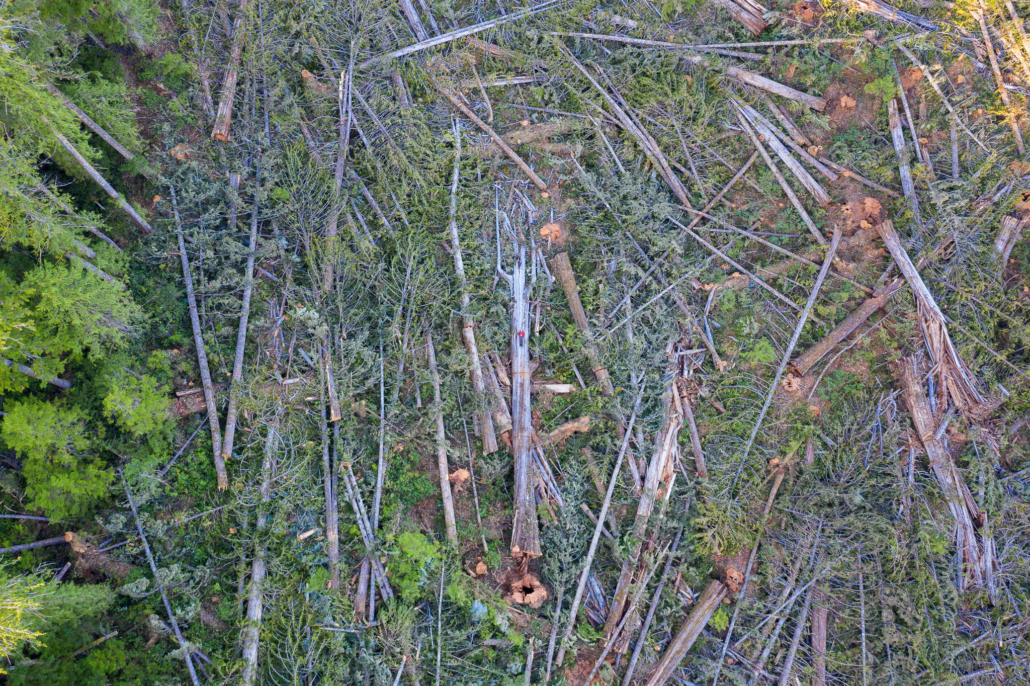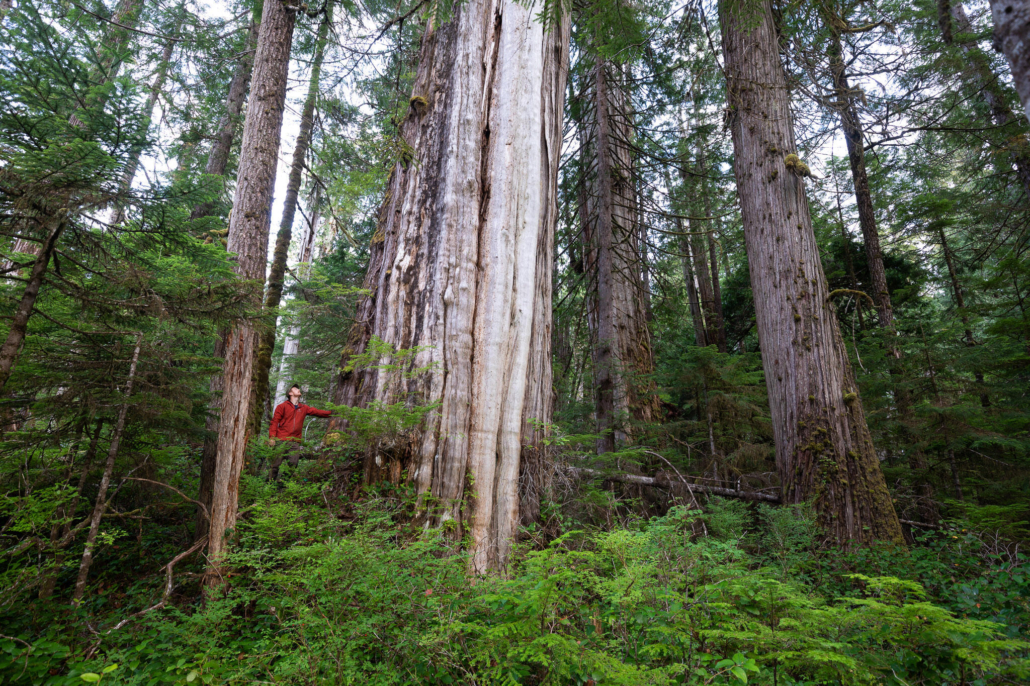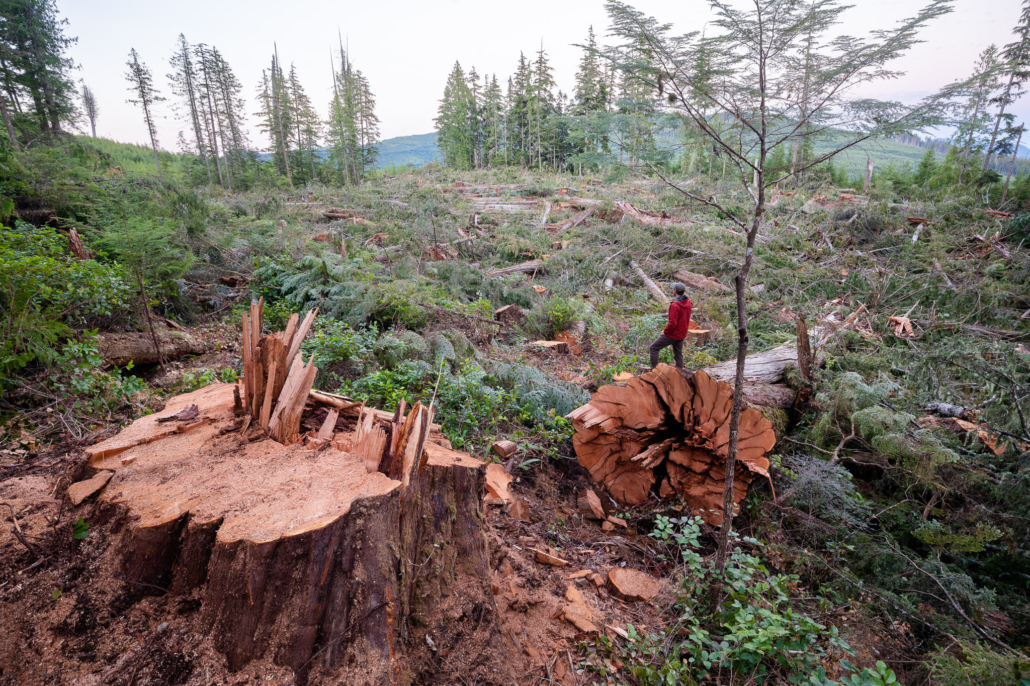 May 10 2023
May 10 2023Clearcutting of Grove of Forest Giants on Northern Vancouver Island – Photos and Videos Document the Destruction
For Immediate Release
May 10, 2023
Shocking photos and drone footage reveal the destruction of rare, big-tree old-growth forests on northern Vancouver Island in Quatsino Sound, highlighting the urgent need for dedicated funding to enable both temporary logging deferrals and permanent, Indigenous-led protected areas initiatives.
Conservationists with the Ancient Forest Alliance have documented with photos and video the clearcutting of a magnificent ancient forest in Quatsino Sound and are urging the BC government to immediately commit funding for old-growth protection to help prevent further loss of the most endangered old-growth forests in BC, plus identify at-risk old-growth forests for deferral that were missed due to mapping errors in the original process.
Ancient Forest Alliance (AFA) members TJ Watt and Ian Thomas came across the fallen remains of a grove of enormous western redcedars — some measuring upwards of 10 feet (3 metres) wide, on a field expedition in 2022. The 25-hectare old-growth cutblock, an area equivalent to over 50 football fields, is located on public lands in Tree Farm Licence 6, which is held by logging company Western Forest Products in Quatsino territory.

AFA’s TJ Watt provides some scale by lying down on the trunk of an old-growth western redcedar tree recently cut by Western Forest Products in Quatsino Sound.
“This was a superlative ancient forest,” stated AFA photographer and campaigner, TJ Watt. “I was floored by the sheer number of monumental redcedars that had been cut down. It was the most shocking example of industrial old-growth logging I’ve witnessed since the logging in the Caycuse and Nahmint Valleys. Dozens of centuries-old trees littered the ground, trees that were taller on their side than I was standing beside them. Some of them were alive earlier that day. After more than a century of high-grade logging in BC, groves of unprotected giants like these are extremely rare to find. To lose another one as special as this is heartbreaking.”
In November 2021, the BC government agreed to implement temporary logging deferrals in 2.6 million hectares of the most at-risk old-growth forests in BC. These priority deferrals were identified by an independent old-growth science panel, the Technical Advisory Panel (TAP), to prevent irreversible biodiversity loss while long-term land use plans are developed. To date, about 1.2 million hectares, or 46%, of priority deferral areas have been agreed upon by First Nations (whose consent and support are a necessity for any new deferrals or protected areas). More than half the areas recommended are still open to logging.
Despite being home to scores of giant trees, many of which would have been 500+ years old, this particular grove — and likely hundreds of others — was not included in the TAP’s original deferral recommendations due to the forest being incorrectly labelled as 210 years old in the province’s forest inventory database (40 years younger than the province’s 250-year-old threshold for being considered old-growth on the coast and to be included in deferral mapping).

A massive old-growth redcedar tree logged on Vancouver Island in Quatsino Sound
The TAP specifically mentioned the issue of inventory errors in their report (see pages 9, 10, 13), making clear recommendations to the BC government that on-the-ground assessments should be used to identify and defer big-tree old-growth forests that were missed in their preliminary analysis. Thus far, it appears the BC government has only used field verification to remove deferral areas that don’t meet the TAP criteria (which are to then be replaced with those that do) in order to facilitate logging, but they are not actively working to identify key old-growth stands that were missed during the TAP analysis due to mapping or inventory errors.
“Knowing that this irreplaceable ancient forest could potentially still be standing today if the BC government was using field verification to identify and defer old-growth forests missed due to mapping errors is a punch in the gut,” stated Watt. “We’ve continually raised this issue with the BC government but so far our concerns have been brushed aside. They only want to subtract old-growth from the priority most-risk category and not add any, even when it is their mistake. Citizens and scientists should be able to submit the locations of old-growth forests that meet the criteria for priority deferral but that have been missed for various reasons. Forest companies should also be obligated to field-verify cutblocks against the TAP deferral criteria before getting approval for logging. These images highlight the devastating impacts on the landscape due to provincial policy and funding gaps.”

AFA’s Ian Thomas stands inside a nearly 10 ft (3 m) wide stump of a fallen western redcedar.
Conservationists argue that without significant funding, it will be nearly impossible to secure the full suite of priority old-growth logging deferrals and their eventual permanent protection, especially in the highest-value old-growth forests with the biggest trees that are most coveted by industry.
“The BC government must come to the table with immediate funding, both in the short and long term, for the deferral and protection of old-growth forests,” explained Watt. “At least $120 million in ‘solution space’ funding is needed immediately to help facilitate logging deferrals by ensuring that First Nations communities aren’t forced to choose between setting aside at-risk old growth and generating revenue for their communities. In the longer term, at least $300 million in conservation financing is needed from the province and another $300 million more from the feds, as well as hundreds of millions more from private donors, to support First Nations’ sustainable economic development, stewardship jobs, and creation of new Indigenous Protected and Conserved Areas (IPCAs) linked to protecting the most at-risk old-growth forests and ecosystems. This can include new land-use planning, Indigenous guardians programs, and the development of sustainable economic alternatives to old-growth logging such as tourism, clean energy, sustainable seafood harvesting, non-timber forest products, and value-added, second-growth forestry.

TJ stands beside a massive redcedar tree growing unprotected adjacent to the cutblock in Quatsino Sound.
Under pressure, the province recently committed to creating a new conservation financing mechanism by the end of June to be filled with philanthropic and private contributions but has yet to publicly commit any of its own funding towards the initiative. The long-awaited BC Canada Nature Agreement and the recent multi-billion dollar provincial budget surplus provide excellent avenues for securing the estimated $800-$1B+ in overall funding necessary to protect the majority of endangered old-growth ecosystems across BC
The Quatsino region on Vancouver Island has historically been hit hard by industrial logging, with less than 25% of its productive (big tree) old-growth forests remaining. Conservation biologists agree that when ecosystems fall below 30% of their original extent, they are at high risk of irreversible biodiversity loss. Despite this ecological emergency, nearby old-growth groves, including some forests specifically recommended for deferral are currently flagged for logging
“Driving to this ancient forest, one must pass through mile after mile of industrial tree farms that have replaced the once magnificent old-growth rainforests of Quatsino Sound. This grove was one of the last fragments of rich old-growth forest remaining in the area, a crucial reservoir of biodiversity and ecological resilience in a damaged landscape,” stated Watt. “Witnessing the disappearance of the last unprotected stands of old-growth forests on Vancouver Island leaves one with a profound sense of ecological grief. The BC government can and must use its vast resources to help pave the path toward the protection of what still remains.”

The BC government has committed to protect 30% of BC’s land area by 2030, to develop a conservation financing mechanism to support Indigenous Protected and Conserved Areas by the end of June, and to target protection for the most biodiverse areas — major commitments that the Ancient Forest Alliance commends. However, missing still is the immediate funding to facilitate deferrals among First Nations, provincial funding for conservation financing (not just a commitment to seek philanthropic funds), and ecosystem-based protected areas targets that include forest productivity distinctions.
This series of images and video is part of work Watt has created with support from the Trebek Initiative, a grantmaking partnership between the National Geographic Society and the Royal Canadian Geographical Society that supports emerging Canadian explorers, scientists, photographers, geographers, and educators with a goal of using storytelling to ignite “a passion to preserve” in all Canadians. Watt was among the first round of grant recipients in 2021 and was named a National Geographic Explorer and Royal Canadian Geographical Society Explorer.
Old-growth forests are vital to support endangered species, First Nations cultures, the climate, clean water, wild salmon, and tourism. Under BC’s current system of forestry, second-growth tree plantations are typically re-logged every 50–60 years, never to become old-growth again.

25 hectares (roughly 50 football fields) of prime old-growth forests were clearcut here in total by Western Forest Products.





